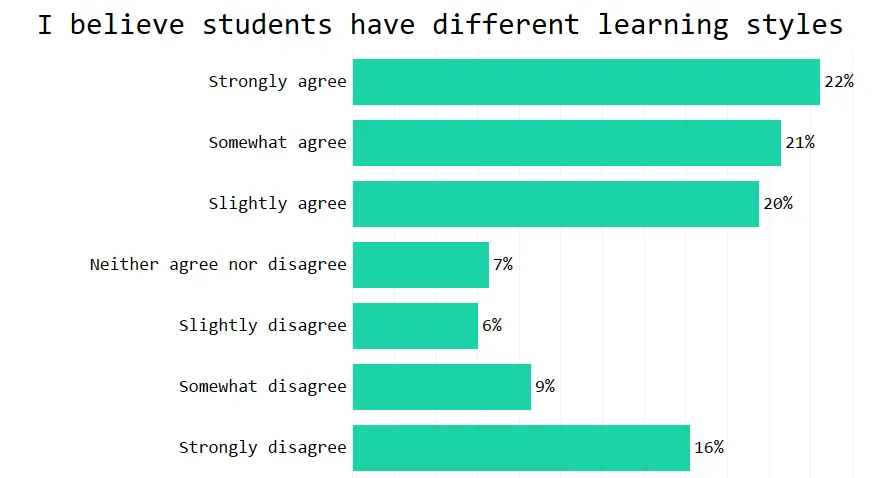There’s a myth that education struggles to shed.
One that holds students back.
And that makes life much harder for teachers than it should be.
It’s the myth of learning styles.
A thread
 https://abs.twimg.com/emoji/v2/... draggable="false" alt="👇" title="Rückhand Zeigefinger nach unten" aria-label="Emoji: Rückhand Zeigefinger nach unten">
https://abs.twimg.com/emoji/v2/... draggable="false" alt="👇" title="Rückhand Zeigefinger nach unten" aria-label="Emoji: Rückhand Zeigefinger nach unten"> https://abs.twimg.com/emoji/v2/... draggable="false" alt="👇" title="Rückhand Zeigefinger nach unten" aria-label="Emoji: Rückhand Zeigefinger nach unten">
https://abs.twimg.com/emoji/v2/... draggable="false" alt="👇" title="Rückhand Zeigefinger nach unten" aria-label="Emoji: Rückhand Zeigefinger nach unten"> https://abs.twimg.com/emoji/v2/... draggable="false" alt="👇" title="Rückhand Zeigefinger nach unten" aria-label="Emoji: Rückhand Zeigefinger nach unten">
https://abs.twimg.com/emoji/v2/... draggable="false" alt="👇" title="Rückhand Zeigefinger nach unten" aria-label="Emoji: Rückhand Zeigefinger nach unten"> https://abs.twimg.com/emoji/v2/... draggable="false" alt="👇" title="Rückhand Zeigefinger nach unten" aria-label="Emoji: Rückhand Zeigefinger nach unten">
https://abs.twimg.com/emoji/v2/... draggable="false" alt="👇" title="Rückhand Zeigefinger nach unten" aria-label="Emoji: Rückhand Zeigefinger nach unten">
One that holds students back.
And that makes life much harder for teachers than it should be.
It’s the myth of learning styles.
A thread
In the 1990s Neil Fleming noticed a common problem in classrooms.
Some students understood information easily - and were learning.
But, others did not understand new information easily.
Some students understood information easily - and were learning.
But, others did not understand new information easily.
Fleming hypothesised the problem was the method of instruction itself.
Teachers taught all students in exactly the same way.
But, students aren’t all the same.
Teachers taught all students in exactly the same way.
But, students aren’t all the same.
Instead, he suggested that different students had preferences for how information should be presented.
And that we should identify them and teach students according their individual preferences. Then they’d learn more in the classroom.
An admirable aim!
And that we should identify them and teach students according their individual preferences. Then they’d learn more in the classroom.
An admirable aim!
After some work, Fleming identified four types of learner:
Visual - prefer seeing things explained in different formats
Aural - prefer hearing spoken explanations
Read/write - prefer reading things
Kinaesthetic - prefer experiencing new information ( https://abs.twimg.com/emoji/v2/... draggable="false" alt="🤷♂️" title="Achselzuckender Mann" aria-label="Emoji: Achselzuckender Mann">)
https://abs.twimg.com/emoji/v2/... draggable="false" alt="🤷♂️" title="Achselzuckender Mann" aria-label="Emoji: Achselzuckender Mann">)
Visual - prefer seeing things explained in different formats
Aural - prefer hearing spoken explanations
Read/write - prefer reading things
Kinaesthetic - prefer experiencing new information (
Fleming created a questionnaire, and soon enough, anybody could identify which learner they were.
And soon, teachers were asked to start planning multiple lessons within one lesson.
With each catering to different ‘styles’ of the learner.
And soon, teachers were asked to start planning multiple lessons within one lesson.
With each catering to different ‘styles’ of the learner.
The idea took off.
Even recent studies suggest that - worldwide - 90% of teachers believe that students have preferred learning styles.
(source) https://www.nature.com/articles/nrn3817">https://www.nature.com/articles/...
--
UK teachers ( @TeacherTapp, 2018)
https://teachertapp.co.uk/what-teachers-tapped-last-week-31-30th-april-2018/
https://teachertapp.co.uk/what-teac... class="Emoji" style="height:16px;" src=" https://abs.twimg.com/emoji/v2/... draggable="false" alt="👇" title="Rückhand Zeigefinger nach unten" aria-label="Emoji: Rückhand Zeigefinger nach unten"> https://abs.twimg.com/emoji/v2/... draggable="false" alt="👇" title="Rückhand Zeigefinger nach unten" aria-label="Emoji: Rückhand Zeigefinger nach unten">
https://abs.twimg.com/emoji/v2/... draggable="false" alt="👇" title="Rückhand Zeigefinger nach unten" aria-label="Emoji: Rückhand Zeigefinger nach unten"> https://abs.twimg.com/emoji/v2/... draggable="false" alt="👇" title="Rückhand Zeigefinger nach unten" aria-label="Emoji: Rückhand Zeigefinger nach unten">
https://abs.twimg.com/emoji/v2/... draggable="false" alt="👇" title="Rückhand Zeigefinger nach unten" aria-label="Emoji: Rückhand Zeigefinger nach unten">
Even recent studies suggest that - worldwide - 90% of teachers believe that students have preferred learning styles.
(source) https://www.nature.com/articles/nrn3817">https://www.nature.com/articles/...
--
UK teachers ( @TeacherTapp, 2018)
https://teachertapp.co.uk/what-teachers-tapped-last-week-31-30th-april-2018/
However, comprehensive reviews of the literature have shown that learning styles don’t help students.
A questionnaire may say you’re an “aural” learner.
But, there’s no evidence you’d learn best by only receiving information in this form.
A questionnaire may say you’re an “aural” learner.
But, there’s no evidence you’d learn best by only receiving information in this form.
Instead, different types of information are suited to different mediums…
For example, spatial information works best on maps.
Musical information is often presented best aurally.
And lots of ideas are best presented through images.
For example, spatial information works best on maps.
Musical information is often presented best aurally.
And lots of ideas are best presented through images.
The idea that students learn best through a "preferred" learning style - is false.
Yet, still, students will claim they are a certain type of learner.
And, teachers are still asked to suit their teaching to different styles of learners.
Yet, still, students will claim they are a certain type of learner.
And, teachers are still asked to suit their teaching to different styles of learners.
This is a false economy.
Using learning styles is a waste of student& #39;s time.
And it& #39;s a waste of teachers time.
Instead, we need to focus on fantastic instruction.
That which suits the type of information being communicated, opposed to the type of learner we’re teaching.
Using learning styles is a waste of student& #39;s time.
And it& #39;s a waste of teachers time.
Instead, we need to focus on fantastic instruction.
That which suits the type of information being communicated, opposed to the type of learner we’re teaching.
Extra resources:
Short article: https://www.theatlantic.com/science/archive/2018/04/the-myth-of-learning-styles/557687/">https://www.theatlantic.com/science/a...
Longer FAQ
http://www.danielwillingham.com/learning-styles-faq.html">https://www.danielwillingham.com/learning-...
@DTWillingham& #39;s book:
https://www.amazon.co.uk/Why-Dont-Students-Like-School/dp/047059196X">https://www.amazon.co.uk/Why-Dont-...
@DaisyChristo’s book
https://www.amazon.co.uk/Seven-Myths-About-Education-Christodoulou/dp/0415746825/ref=pd_lpo_14_t_0/260-3166208-8687231?_encoding=UTF8&pd_rd_i=0415746825&pd_rd_r=5dcea0bb-8280-4e8a-ba13-c69da72002af&pd_rd_w=Qgclu&pd_rd_wg=M3b0w&pf_rd_p=7b8e3b03-1439-4489-abd4-4a138cf4eca6&pf_rd_r=DCJGT10ESFP6DQ1J4CKX&psc=1&refRID=DCJGT10ESFP6DQ1J4CKX">https://www.amazon.co.uk/Seven-Myt...
Short article: https://www.theatlantic.com/science/archive/2018/04/the-myth-of-learning-styles/557687/">https://www.theatlantic.com/science/a...
Longer FAQ
http://www.danielwillingham.com/learning-styles-faq.html">https://www.danielwillingham.com/learning-...
@DTWillingham& #39;s book:
https://www.amazon.co.uk/Why-Dont-Students-Like-School/dp/047059196X">https://www.amazon.co.uk/Why-Dont-...
@DaisyChristo’s book
https://www.amazon.co.uk/Seven-Myths-About-Education-Christodoulou/dp/0415746825/ref=pd_lpo_14_t_0/260-3166208-8687231?_encoding=UTF8&pd_rd_i=0415746825&pd_rd_r=5dcea0bb-8280-4e8a-ba13-c69da72002af&pd_rd_w=Qgclu&pd_rd_wg=M3b0w&pf_rd_p=7b8e3b03-1439-4489-abd4-4a138cf4eca6&pf_rd_r=DCJGT10ESFP6DQ1J4CKX&psc=1&refRID=DCJGT10ESFP6DQ1J4CKX">https://www.amazon.co.uk/Seven-Myt...

 Read on Twitter
Read on Twitter


 )" title="After some work, Fleming identified four types of learner:Visual - prefer seeing things explained in different formatsAural - prefer hearing spoken explanationsRead/write - prefer reading things Kinaesthetic - prefer experiencing new information (https://abs.twimg.com/emoji/v2/... draggable="false" alt="🤷♂️" title="Achselzuckender Mann" aria-label="Emoji: Achselzuckender Mann">)" class="img-responsive" style="max-width:100%;"/>
)" title="After some work, Fleming identified four types of learner:Visual - prefer seeing things explained in different formatsAural - prefer hearing spoken explanationsRead/write - prefer reading things Kinaesthetic - prefer experiencing new information (https://abs.twimg.com/emoji/v2/... draggable="false" alt="🤷♂️" title="Achselzuckender Mann" aria-label="Emoji: Achselzuckender Mann">)" class="img-responsive" style="max-width:100%;"/>








